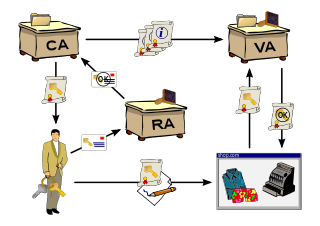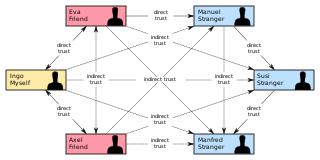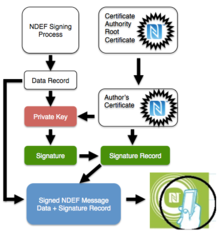Pretty Good Privacy (PGP) is an encryption program that provides cryptographic privacy and authentication for data communication. PGP is used for signing, encrypting, and decrypting texts, e-mails, files, directories, and whole disk partitions and to increase the security of e-mail communications. Phil Zimmermann developed PGP in 1991.

Public-key cryptography, or asymmetric cryptography, is the field of cryptographic systems that use pairs of related keys. Each key pair consists of a public key and a corresponding private key. Key pairs are generated with cryptographic algorithms based on mathematical problems termed one-way functions. Security of public-key cryptography depends on keeping the private key secret; the public key can be openly distributed without compromising security.
In law, non-repudiation is a situation where a statement's author cannot successfully dispute its authorship or the validity of an associated contract. The term is often seen in a legal setting when the authenticity of a signature is being challenged. In such an instance, the authenticity is being "repudiated".

A digital signature is a mathematical scheme for verifying the authenticity of digital messages or documents. A valid digital signature on a message gives a recipient confidence that the message came from a sender known to the recipient.
Transport Layer Security (TLS) is a cryptographic protocol designed to provide communications security over a computer network. The protocol is widely used in applications such as email, instant messaging, and voice over IP, but its use in securing HTTPS remains the most publicly visible.

A public key infrastructure (PKI) is a set of roles, policies, hardware, software and procedures needed to create, manage, distribute, use, store and revoke digital certificates and manage public-key encryption.
In cryptography, a public key certificate, also known as a digital certificate or identity certificate, is an electronic document used to prove the validity of a public key. The certificate includes the public key and information about it, information about the identity of its owner, and the digital signature of an entity that has verified the certificate's contents. If the device examining the certificate trusts the issuer and finds the signature to be a valid signature of that issuer, then it can use the included public key to communicate securely with the certificate's subject. In email encryption, code signing, and e-signature systems, a certificate's subject is typically a person or organization. However, in Transport Layer Security (TLS) a certificate's subject is typically a computer or other device, though TLS certificates may identify organizations or individuals in addition to their core role in identifying devices. TLS, sometimes called by its older name Secure Sockets Layer (SSL), is notable for being a part of HTTPS, a protocol for securely browsing the web.
In cryptography, X.509 is an International Telecommunication Union (ITU) standard defining the format of public key certificates. X.509 certificates are used in many Internet protocols, including TLS/SSL, which is the basis for HTTPS, the secure protocol for browsing the web. They are also used in offline applications, like electronic signatures.

In cryptography, a web of trust is a concept used in PGP, GnuPG, and other OpenPGP-compatible systems to establish the authenticity of the binding between a public key and its owner. Its decentralized trust model is an alternative to the centralized trust model of a public key infrastructure (PKI), which relies exclusively on a certificate authority. As with computer networks, there are many independent webs of trust, and any user can be a part of, and a link between, multiple webs.
In cryptography, a certificate authority or certification authority (CA) is an entity that stores, signs, and issues digital certificates. A digital certificate certifies the ownership of a public key by the named subject of the certificate. This allows others to rely upon signatures or on assertions made about the private key that corresponds to the certified public key. A CA acts as a trusted third party—trusted both by the subject (owner) of the certificate and by the party relying upon the certificate. The format of these certificates is specified by the X.509 or EMV standard.
The Domain Name System Security Extensions (DNSSEC) are a suite of extension specifications by the Internet Engineering Task Force (IETF) for securing data exchanged in the Domain Name System (DNS) in Internet Protocol (IP) networks. The protocol provides cryptographic authentication of data, authenticated denial of existence, and data integrity, but not availability or confidentiality.
In cryptography, a message authentication code (MAC), sometimes known as an authentication tag, is a short piece of information used for authenticating and integrity-checking a message. In other words, to confirm that the message came from the stated sender and has not been changed. The MAC value allows verifiers to detect any changes to the message content.
S/MIME is a standard for public-key encryption and signing of MIME data. S/MIME is on an IETF standards track and defined in a number of documents, most importantly RFC 8551. It was originally developed by RSA Data Security, and the original specification used the IETF MIME specification with the de facto industry standard PKCS #7 secure message format. Change control to S/MIME has since been vested in the IETF, and the specification is now layered on Cryptographic Message Syntax (CMS), an IETF specification that is identical in most respects with PKCS #7. S/MIME functionality is built into the majority of modern email software and interoperates between them. Since it is built on CMS, MIME can also hold an advanced digital signature.
In cryptography and computer security, self-signed certificates are public key certificates that are not issued by a certificate authority (CA). These self-signed certificates are easy to make and do not cost money. However, they do not provide any trust value.
XML Signature defines an XML syntax for digital signatures and is defined in the W3C recommendation XML Signature Syntax and Processing. Functionally, it has much in common with PKCS #7 but is more extensible and geared towards signing XML documents. It is used by various Web technologies such as SOAP, SAML, and others.
DomainKeys Identified Mail (DKIM) is an email authentication method designed to detect forged sender addresses in email, a technique often used in phishing and email spam.
The ANSI X9.95 standard for trusted timestamps expands on the widely used RFC 3161 - Internet X.509 Public Key Infrastructure Time-Stamp Protocol by adding data-level security requirements that can ensure data integrity against a reliable time source that is provable to any third party. Applicable to both unsigned and digitally signed data, this newer standard has been used by financial institutions and regulatory bodies to create trustworthy timestamps that cannot be altered without detection and to sustain an evidentiary trail of authenticity. Timestamps based on the X9.95 standard can be used to provide:
ISO/IEC 20248Automatic Identification and Data Capture Techniques – Data Structures – Digital Signature Meta Structure is an international standard specification under development by ISO/IEC JTC 1/SC 31/WG 2. This development is an extension of SANS 1368, which is the current published specification. ISO/IEC 20248 and SANS 1368 are equivalent standard specifications. SANS 1368 is a South African national standard developed by the South African Bureau of Standards.
DNS Certification Authority Authorization (CAA) is an Internet security policy mechanism that allows domain name holders to indicate to certificate authorities whether they are authorized to issue digital certificates for a particular domain name. It does this by means of a "CAA" Domain Name System (DNS) resource record.
The Web Cryptography API is the World Wide Web Consortium’s (W3C) recommendation for a low-level interface that would increase the security of web applications by allowing them to perform cryptographic functions without having to access raw keying material. This agnostic API would perform basic cryptographic operations, such as hashing, signature generation and verification and encryption as well as decryption from within a web application.





